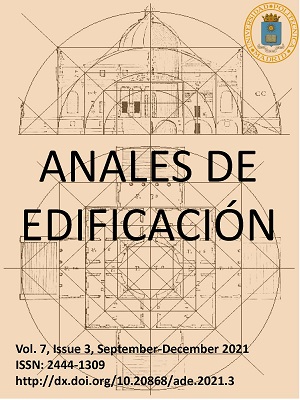Influencia del refuerzo de fibra de acero y basalto en la resistencia a las heladas y los parámetros mecánicos de fractura del hormigón de alta resistencia = Influence of basalt and steel fiber reinforcement on the frost resistance and fracture mechanic parameters of high strength concrete
DOI:
https://doi.org/10.20868/ade.2021.4968Palabras clave:
Fibra de acero, fibra de basalto, hormigón de alta resistencia, parámetros de fractura, resistencia a las heladas, Steel fiber, basalt fiber, high strength concrete, fracture parameters, frost resistanceResumen
La resistencia a las heladas es una de las características más importantes que describen un elemento estructural de hormigón. En condiciones de procesos de congelación/descongelación frecuentes y repetidos, la estructura se debilita significativamente. Los parámetros físicos que describen el material asumido en la etapa de diseño comienzan a desviarse significativamente de las estimaciones iniciales a medida que avanza la degradación. Con el fin de aumentar la durabilidad de los elementos estructurales expuestos a ciclos de congelación/descongelación, a principios de la década de 1980 se introdujo una nueva generación de hormigones con mejores propiedades de resistencia y durabilidad. Estos hormigones, a pesar de sus muchas ventajas, se caracterizan por una mayor fragilidad y susceptibilidad a la retracción. En este estudio se determinó el efecto de la adición de un 0,5% en volumen de fibras de acero y una mezcla de fibras de acero y basalto sobre la resistencia a las heladas de hormigones con una resistencia de 90 MPa. Se presentó el grado de resistencia de los hormigones al descascarillado superficial en condiciones de tensión durante ciclos de congelación/descongelación. El análisis se basó en las normas ASTM C 666 y PKN - CEN/TS 12390 Slab Test y RILEM. Se determinó el cambio del parámetro que describe la fragilidad y el factor de intensidad de tensión del concreto de alta resistencia debido al ciclo de hielo/deshielo después de 150, 250, 350 y 450 ciclos.
Abstract
Frost resistance is one of the most important characteristics describing a concrete structural element. Under conditions of frequent, repeatedly occurring freeze/thaw processes, the structure is significantly weakened. The physical parameters describing the material assumed at the design stage begin to deviate significantly from the initial estimates as the degradation progresses. In order to increase the durability of structural elements exposed to cyclic freeze/thaw, a new generation of concretes with improved strength and durability properties was introduced in the early 1980s. These concretes, despite their many advantages, are characterised by increased brittleness and susceptibility to shrinkage. In this study, the effect of a 0.5% by volume addition of steel fibres and a mixture of steel and basalt fibres on the frost resistance of concretes with a strength of 90 MPa was determined. The degree of resistance of concretes to surface scaling under stress conditions during cyclic freeze/thaw was presented. The analysis was based on ASTM C 666 and PKN - CEN/TS 12390 Slab Test and RILEM standards. The change of the parameter describing brittleness and the stress intensity factor of high-strength concrete due to cyclic freeze/thaw after 150,250,350 and 450 cycles were determined.
Descargas
Referencias
ASTM C 666, Standard Test Method for Resistance of Concrete to Rapid Freezing and Thawing, Annual Book of ASTM Standards, 1991.
Bywalski C., Kamiński M., Morga K., The influence of steel fibers content in concrete on the plastic properties of composite. Concrete days 2010.
Hale W. M., Freyne S. F., Russell B.W., Examining the frost resistance of high performance concrete, Construction and Building Materials 23 (2009), 878 -888.
Hasan-Nattaj F., Nematzadeh Mahdi, The effect of forta-ferro and steel fibers on mechanical properties of high-strength concrete with and without silica fume and nano-silica, Construction and Building Materials 137 (2017), 557-572.
Karakurt C., Bayazıt Y., Freeze-Thaw Resistance of Normal and High Strength Concretes Produced with Fly Ash and Silica Fume, Advances in material science and civil engineering (2015).
Kosior-Kazberuk M., Resistance of concrete to scaling caused by cyclic freezing under static loading, Scientific Journals of the Rzeszów University of Technology 59 (2012), 233 – 240.
Kustermann A., Keuser M., The influence of steel fibers content in concrete on the plastic properties of composite, 6th Symposium on Fibre-Reinforced Concretes 2004, 1217 – 1226.
Luo X., Sun W., Chan S.Y.N., Steel fiber reinforced high-performance concrete: a study on the mechanical properties and resistance against impact, Materials and Structures 34 (2001), 144-149.
Recommendation TC 89-FMT RILEM, Determination of fracture parameters (KIc and CTODc) of plain concrete using three-point bend test, Materials and Structures 23 (1990), 457-460.
R.N. Swamy, High-strength concrete-material properties and structural behaviors, ACI J. 87 (1987), 110–146.
Ruiz, D. (2015). Http://repositorio.upn.edu.pe/handle/ - 11537/10524. Obtenido de Influencia de la adición de vidrio triturado en la resistencia a la compresión axial de un ladrillo de arcilla artesanal de Cajamarca, 2015: http://repositorio.upn.edu.pe/handle/11537/10524
Song P.S., Hwang S., Mechanical properties of high-strength steel fiber-reinforced concrete, Construction and Building Materials 18 (2004), 669-673.
SS 13 72 44:1995. Concretetesting; Hardened concrete; Scaling at freezing. Swedish Standard.
Descargas
Publicado
Número
Sección
Licencia
1. Los autores conservan los derechos de autor y garantizan a la revista el derecho de una Licencia Creative Commons Atribución - Nocomercial 4.0 Internacional que permite a otros compartir el trabajo con un reconocimiento de la autoría y uso no comercial.
2. Los autores pueden establecer por separado acuerdos adicionales para la distribución no exclusiva de la versión de la obra publicada en la revista (por ejemplo, situarlo en un repositorio institucional o publicarlo en un libro).
Salvo indicación contraria, todos los contenidos de la edición electrónica se distribuyen bajo una licencia de uso y distribución “Creative Commons"












